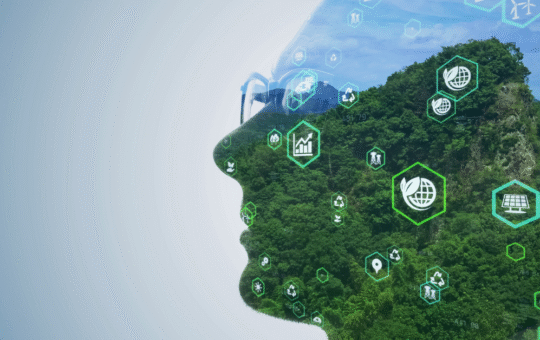Intermediate

Level 3 Certificate in Environmental Management Systems (ISO 14001)
Level 3 Certificate in Environmental Management Systems (ISO 14001)Course OverviewThe Level 3 Certificate in Environmental Management Systems (ISO 14001) provides learners with a comprehensive understanding of how to design, implement, and manage an effective Environmental Management System (EMS) based on the globally recognized ISO 14001 standard. The course focuses on the principles and practices necessary to develop, operate, and continually improve an EMS in various organizational settings. Learners will gain the skills required to support organizations in minimizing their environmental impact and complying with legal and regulatory requirements.Benefits
Study Units Breakdown
Who is This Designed For?This certificate is ideal for:
- Gain a practical understanding of the ISO 14001 standard and how it applies to environmental management.
- Learn how to implement and maintain an EMS to achieve sustainability and regulatory compliance.
- Enhance your career prospects by gaining expertise in a globally recognized environmental standard.
- Understand the benefits of reducing environmental impact, including cost savings and improved corporate reputation.
- Develop the skills to lead internal audits, risk assessments, and continuous improvement initiatives related to environmental performance.
- Gain insight into how to align environmental management practices with broader organizational goals.
- Understand the core principles and requirements of ISO 14001:2015.
- Design and implement an EMS in accordance with ISO 14001 standards.
- Identify and assess environmental impacts within an organization.
- Plan and execute environmental audits and assessments.
- Develop and implement strategies for continual improvement of environmental performance.
- Support organizations in meeting legal and regulatory environmental obligations.
- Lead and support environmental management initiatives at various organizational levels.
- Introduction to Environmental Management and ISO 14001
- Overview of environmental management and the need for an EMS.
- Introduction to ISO 14001 and its history, scope, and purpose.
- Key concepts and terminology in environmental management.
- The benefits of implementing ISO 14001 for organizations and the environment.
- The structure and clauses of ISO 14001:2015.
- The role of ISO 14001 in sustainable development and corporate social responsibility (CSR).
- ISO 14001:2015 Requirements and Clauses
- Understanding the key clauses of ISO 14001:2015: Context of the organization, leadership, planning, support, operation, performance evaluation, and improvement.
- The importance of leadership and top management commitment in EMS implementation.
- Understanding the need for a policy and objectives in EMS.
- The process of risk-based thinking and how to identify environmental risks and opportunities.
- How to determine environmental aspects and impacts.
- Aligning EMS with organizational business processes and strategies.
- Environmental Policy and Objectives
- Developing an environmental policy that reflects organizational commitments to sustainability.
- Setting measurable and achievable environmental objectives in line with ISO 14001.
- Understanding how to set targets and indicators for environmental performance.
- Integrating environmental policies and objectives into day-to-day operations.
- Communicating environmental policies to stakeholders and employees.
- Reviewing and updating policies and objectives regularly for continual improvement.
- Environmental Planning: Risk and Opportunity Management
- Identifying and assessing environmental aspects, impacts, and risks.
- Determining legal and other compliance obligations related to environmental performance.
- Conducting environmental risk assessments and prioritizing action plans.
- Developing procedures to address significant environmental risks and opportunities.
- Integrating sustainability goals and business objectives into environmental planning.
- How to document, manage, and monitor environmental performance and improvements.
- Implementation and Operation of EMS
- How to assign roles and responsibilities for environmental management within an organization.
- Developing the resources, competencies, and awareness necessary to implement EMS effectively.
- The role of communication and engagement in the EMS process.
- Establishing procedures for operational control and emergency preparedness.
- Ensuring compliance with environmental laws, regulations, and other requirements.
- Managing supplier relationships and ensuring environmental considerations are embedded in the supply chain.
- Performance Evaluation and Internal Audits
- Understanding the process of monitoring, measurement, analysis, and evaluation of environmental performance.
- Key performance indicators (KPIs) for tracking the effectiveness of EMS.
- Conducting internal audits and assessments for EMS compliance and effectiveness.
- Auditing techniques and best practices for ensuring ongoing compliance with ISO 14001.
- Evaluating corrective and preventive actions based on audit findings.
- How to use audit results for continuous improvement in environmental management.
- Continual Improvement and Corrective Actions
- The importance of continual improvement in ISO 14001 and EMS.
- Identifying areas for improvement through monitoring and auditing processes.
- Corrective actions for addressing non-conformities and deviations.
- Preventive actions to mitigate future risks and prevent environmental impacts.
- How to create a culture of continuous improvement within the organization.
- The role of management reviews in driving ongoing environmental performance.
- ISO 14001 Certification Process
- The steps involved in achieving ISO 14001 certification.
- Understanding the requirements for certification and how to prepare for an audit.
- Selecting an accredited certification body and preparing for external audits.
- The role of external audits in verifying compliance with ISO 14001.
- Post-certification activities: maintaining compliance, recertification, and surveillance audits.
- Benefits of ISO 14001 certification for organizations and stakeholders.
| Attribute | Description |
| Qualification Title | Level 3 Certificate in Environmental Management Systems (ISO 14001) |
| Level | 3 |
| Type | Certificate |
| Total Qualification Time (TQT) | 160 hours |
| Guided Learning Hours (GLH) | 80 hours |
| Credit Value | 16 credits |
| Assessment Method | MCQ-based |
| Grading | Pass/Fail |
| Delivery Mode | Classroom / Online / Blended |
| Unit Title | GLH | TQT | Credit | Assessment Type |
| Introduction to Environmental Management and ISO 14001 | 10 | 20 | 2 | MCQ-based |
| ISO 14001:2015 Requirements and Clauses | 12 | 24 | 3 | MCQ-based |
| Environmental Policy and Objectives | 10 | 20 | 2 | MCQ-based |
| Environmental Planning: Risk and Opportunity Management | 10 | 20 | 2 | MCQ-based |
| Implementation and Operation of EMS | 10 | 20 | 2 | MCQ-based |
| Performance Evaluation and Internal Audits | 10 | 20 | 2 | MCQ-based |
| Continual Improvement and Corrective Actions | 10 | 20 | 2 | MCQ-based |
| ISO 14001 Certification Process | 8 | 16 | 1 | MCQ-based |
- Environmental managers, officers, or consultants who want to gain knowledge of ISO 14001.
- Professionals looking to develop, implement, or manage an EMS.
- Internal auditors and environmental compliance specialists.
- Sustainability officers, project managers, and operations managers in organizations seeking to improve their environmental performance.
- Individuals pursuing careers in environmental management and corporate sustainability.
- Take on roles such as Environmental Management System (EMS) Coordinator, Environmental Compliance Officer, or Environmental Auditor.
- Pursue careers in sustainability, risk management, and environmental consultancy.
- Advance to more senior positions, such as Environmental Manager or Environmental Compliance Manager.
- Continue further studies in ISO 14001 or other environmental management and sustainability qualifications.
- Work for organizations that require ISO 14001 certification or aim to improve their environmental performance.
- Expert-Led Learning: Learn from instructors with practical experience in environmental management and ISO 14001.
- Hands-On Experience: Engage in real-world scenarios and case studies that help develop practical skills.
- Globally Recognized Certification: The ISO 14001 standard is recognized worldwide, ensuring that your qualification is valued globally.
- Comprehensive Curriculum: Covers all essential aspects of ISO 14001, from planning and implementation to audits and continual improvement.
- Career-Boosting Skills: Master the skills required to improve organizational environmental performance and gain a competitive edge in the job market.
Qualification Profile
| Attribute | Description |
| Qualification Title | Level 3 Certificate in Environmental Management Systems (ISO 14001) |
| Level | 3 |
| Type | Certificate |
| Total Qualification Time (TQT) | 160 hours |
| Guided Learning Hours (GLH) | 80 hours |
| Credit Value | 16 credits |
| Assessment Method | MCQ-based |
| Grading | Pass/Fail |
| Delivery Mode | Classroom / Online / Blended |
Study Units Breakdown
| Unit Title | GLH | TQT | Credit | Assessment Type |
| Introduction to Environmental Management and ISO 14001 | 10 | 20 | 2 | MCQ-based |
| ISO 14001:2015 Requirements and Clauses | 12 | 24 | 3 | MCQ-based |
| Environmental Policy and Objectives | 10 | 20 | 2 | MCQ-based |
| Environmental Planning: Risk and Opportunity Management | 10 | 20 | 2 | MCQ-based |
| Implementation and Operation of EMS | 10 | 20 | 2 | MCQ-based |
| Performance Evaluation and Internal Audits | 10 | 20 | 2 | MCQ-based |
| Continual Improvement and Corrective Actions | 10 | 20 | 2 | MCQ-based |
| ISO 14001 Certification Process | 8 | 16 | 1 | MCQ-based |
Upon completing this certificate, learners will be able to:
- Understand the core principles and requirements of ISO 14001:2015.
- Design and implement an EMS in accordance with ISO 14001 standards.
- Identify and assess environmental impacts within an organization.
- Plan and execute environmental audits and assessments.
- Develop and implement strategies for continual improvement of environmental performance.
- Support organizations in meeting legal and regulatory environmental obligations.
- Lead and support environmental management initiatives at various organizational levels.
This certificate is ideal for:
- Environmental managers, officers, or consultants who want to gain knowledge of ISO 14001.
- Professionals looking to develop, implement, or manage an EMS.
- Internal auditors and environmental compliance specialists.
- Sustainability officers, project managers, and operations managers in organizations seeking to improve their environmental performance.
- Individuals pursuing careers in environmental management and corporate sustainability.
Assessment Type: MCQ-based
Top Courses
Related Courses
Let's Get in touch
Deleting Course Review
Are you sure? You can't restore this back
Course Access
This course is password protected. To access it please enter your password below:



